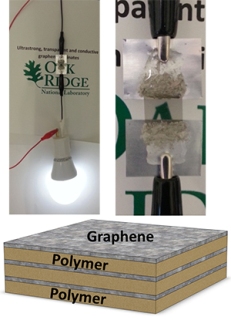May 18 2015
Researchers at the Department of Energy’s Oak Ridge National Laboratory (ORNL) have developed a new method for commercial-scale fabrication of graphene. This could lead to significant advances in flexible electronics, and could possibly change the manner in which graphene is viewed and utilized.
 ORNL’s ultrastrong graphene features layers of graphene and polymers and is an effective conductor of electricity.
ORNL’s ultrastrong graphene features layers of graphene and polymers and is an effective conductor of electricity.
Ivan Vlassiouk of ORNL has led a team of researchers who fabricated polymer composites using chemical vapor deposition method. These composites contain graphene sheets of 2”x2” size. Graphene is a one-atom thick material that is made up of carbon atoms arranged hexagonally. It is stiffer and stronger than carbon fiber.
So far, researchers have only been able to use small flakes of graphene, as it has not been practically possible to utilize graphene on a large scale.
“Before our work, superb mechanical properties of graphene were shown at a micro scale,” said Vlassiouk, a member of ORNL’s Energy and Transportation Science Division. “We have extended this to a larger scale, which considerably extends the potential applications and market for graphene.”
The research team utilized graphene sheets that were comparatively larger than other commonly used approaches for construction of polymer nanocomposition. Other approaches conventionally use tiny flakes of carbon nanomaterials or graphene
However, they do not get dispersed in the polymer easily. The issues faced in dispersion of flakes and agglomeration is overcome by using larger graphene sheets. Furthermore, this enables better electrical conductivity while utilizing lesser amount of graphene in the polymer material.
“In our case, we were able to use chemical vapor deposition to make a nanocomposite laminate that is electrically conductive with graphene loading that is 50 times less compared to current state-of-the-art samples,” Vlassiouk said. This process could play an important role in successful commercialization of the product and make it competitive.
If scalability of the process could be achieved, and if the cost of the process could be reduced, then graphene could be utilized in a wide range of industries. In the aerospace industry it could be used for conductivity, anti-icing, flame-retardant and structural monitoring applications; in manufacturing it could be used for filtration, barrier coatings and as catalysts; in electronics it could be applied for thermal management, printed electronics, and displays.
In structural applications graphene could be used for temperature control materials and self-cleaning coatings; in the energy industry it could be used for energy storage, filtration and photovoltaics; and in the automotive sector graphene could be used for wear-resistant coatings and catalysts.
This study has been published as a paper, titled “Strong and Electrically Conductive Graphene Based Composite Fibers and Laminates,” in the journal Applied Materials & Interfaces.
ORNL’s Laboratory Directed Research and Development program provided support for this study. Some of the work involved in this study was performed at the Center for Nanophase Materials Sciences.